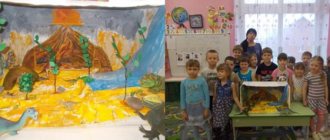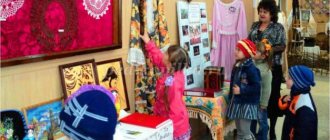Collecting in kindergarten. From work experience
Collecting is a form of organizing cognitive and research activities of preschool children
Author: Tatyana Ivanovna Valisevich, kindergarten teacher Place of work: Kindergarten No. 206 of JSC Russian Railways Purpose: This information will be of interest to educators and parents. Program content Goal: Development of cognitive and research activities in preschool children through collecting. Objectives: To develop an emotional and cognitive attitude towards the world around us. Strengthen children's ability to observe and compare. Develop the creative potential of students. Replenish the subject-development environment with collecting materials. Description: This information allows you to understand how significant the collection is for a child. Nowadays they write and talk a lot about the subject-development environment of children, both at home and in kindergarten. We decided to expand this topic a little in our group by asking children and their parents to share their collections for a while. There are so many new and interesting things you can see when playing with her in a group. When a child collects a collection at home and only he plays with it, this is one way of learning about the subject-development environment. But if he brings his collection to the team, he will see and hear a lot of interesting things both about it and about his best qualities, since few adults would dare to entrust their “treasure,” not to mention children. It is impossible to express in words how passionate the children are about the game; even the owner of the collection himself discovers something new. My children are 3-4 years old and in order to occupy them with something interesting for 20 minutes, I still have to try. But with collections, this does not happen; children play for 20-30 minutes without leaving it. Naturally, I myself am busy with them. Kindersurprise collections are especially popular. Three children brought such collections, and everyone found something new and unusual. If it were possible to insert a video, then everyone could see and hear what kind of dialogue the children are having, how they act out, invent, name toys and much more interesting things. And so I want to share with you the photographs I took while playing with the collections.
We recommend watching:
Project in the senior group of a kindergarten Abstract of a scientific and educational activity with elements of experimental research activities in the senior group, compensating for example Collecting in kindergarten Optimization of cognitive and speech development of preschool children through collecting
Similar articles:
Dance festival in kindergarten for children 5-7 years old. Scenario
Outdoor games as a means of harmonious development of a child
From work experience. Nurturing a culture of verbal communication in preschoolers
How to write a character reference for a child in kindergarten
Features of the intellectual development of preschool children
Emotional side
— As I understand it, both the collector and the collector receive some kind of emotional boost from things when you “hunt” for it, during the purchase, or when you already own it. In our age of consumption, people have become very emotionally dependent on things, which seems to be a bad habit. And we raise our children in this. Parents want their child to collect, but in the end they get him hooked on “materialism.” What do you think about this?
— When there are a lot of toys, the child begins to get used to it, and for him there is no special value or joy when a parent buys him another toy. This leads to spoiling and has a very bad effect on the child. In such cases, parents risk getting their child hooked on constant purchases of toys and other things that cost a lot of money. It is more important for a parent to provide emotional nourishment to the child in the form of full attention to him, hugs, kisses, affectionate words, and spending time together. And if you really want to please your child with a purchase, you should do it with the words: “We bought this for you because we love you!” This position is the most correct.
— The rooms need to be cleaned periodically. Parents gradually throw away or give away excess, often secretly from the child, sometimes not. But all children get upset when their parents start managing their things. Is this normal for a child?
— If a parent buys any thing or toy for a child, it becomes his property. Adults also have their own personal belongings - telephone, car, books, which are not easy for them to give up.
Imagine that one day someone came to you and took your phone or car keys. What feelings will you have?
If you put yourself in the shoes of a child, it will be even harder for him to give up his things. Even if these things lie idle and are not needed by the child for a long time. And it's not about greed at all. The point is that in this case the child is not asked how he himself would like to dispose of his property.
It is more advisable to talk with the child about his toys, about what he does not need YET, and what will be useful in the near future for games. Put away what is unnecessary in boxes on the balcony, in the mezzanine, or, if the child is ready, throw it away or give it to someone. This will allow the child to avoid resentment and anger that his parents treated him unfairly. Throwing away toys, especially when a child knows about it, leaves a deep imprint on his soul. The feeling that he cannot have something in life is not an individual person who cannot make decisions himself, manage his things. This could lead to complications in many situations in the future.
— How to gently and without mental trauma get rid of unnecessary “jewels”, but in fact, unnecessary trash?
— I have already written about the importance of talking to children. Why is this toy (candy wrapper, pebble, sticker) dear to him? Why is he not ready to break up with her at the moment? What does she mean to him? The answers to these questions will give parents much more than just knowledge about their child’s stubbornness to never part with their favorite (and not so favorite) things. I imagine bewilderment, and maybe even indignation of the parents: “So what, ask this for each candy wrapper, but what if there are a hundred of them? What if there is so much rubbish that the child is no longer visible behind it?!” In this situation, I understand parents who want the best for their child - a clean and tidy room, order in the house.
But, I repeat, “collecting” a variety of things for a child and owning them is one of the stages of his development as a person. Fortunately, it passes painlessly if the child in the family meets understanding and acceptance of his collecting. Parents just have to be patient.
I can give advice if completely scattered things are annoying. In this case, there can be only one way out - to instill in the child responsibility for order in his things. Moreover, use short phrases or words: “I see candy wrappers on the floor,” “I notice that the figures are out of place.” You can ask the question: “How long will it take you to remove all this?” For younger children, you can use sequential steps: “First remove this, then something else,” that is, splitting one large task into several small, less complex ones.
If such phrases do not work on your child, you can tell him about the consequences. Again, with respect and understanding: “If you can’t handle so many toys, I’ll have to remove some of them. I know you won’t like it very much, but until you figure out how to organize your room, they won’t be available to you.” Over time, the child will learn to take responsibility for order and throw away unnecessary things if they no longer need them.
Crafts for March 8th for school competition
Elementary school students will be happy to make cute souvenirs for mom on March 8th. If you make a craft carefully, using maximum originality and skill, your child can take part in a school craft competition with his masterpiece.
For children 7-8 years old, choose ideas more easily, and from 9-11 years old you can make complex compositions in the quilling style with children, take up knitting and embroidery.
For children 1-2 grades
Children in grades 1-2 need to be given freedom for creativity and imagination. Especially if they want to bring all their most original ideas to life. Show them a selection of ideas for crafts for your beloved mothers using a presentation, and they themselves will choose the appropriate option.
From salt dough
Making crafts from salt dough is a long but very exciting process. You need to prepare for it in advance so that the souvenir will be ready on the eve of the holiday and dry well.
- Colorful basket.
- Candlesticks.
- Panel.
- Original refrigerator magnets.
- Hearts.
- Souvenirs in pots.
- Jewelry for the box.
Salt dough is a favorite material for creative children. You can make anything out of it. Such souvenirs delight teachers, adults and children.
From felt
Not only toys are made from soft and pliable felt, but also original crafts as gifts for adults. To make them, it is not necessary to use threads or a needle. Felt easily sticks to cardboard and is fastened with buttons and snaps. But for the craft lesson you will need patterns or drawings.
- Bouquets of soft flowers.
- Potholder.
- Pincushion.
- Collection of flowers.
- Toys.
- Baskets.
You can put sweets, cookies, paper flowers in them.
- Handbags.
- Butterflies.
To cut out small parts, choose felt with a thickness of 1 mm, then the toys will turn out more neat.
For children 3-5 grades
It is best to make crafts for March 8 from scrap materials. Take colored paper, for example, corrugated material is good for voluminous cards. Or introduce your children to quilling techniques.
Corrugated paper
This is a thin and bright material. Corrugated paper is easy to glue in several layers. From such pliable material, children in grades 3-5 can make lush flowers, chic cards or paintings.
- Hyacinth.
- Tulips.
- Basket with roses.
- Postcards.
- Gladioli.
To ensure that flower petals made from corrugated paper are correct and neat, draw your own stencil for each plant, only then start cutting.
Quilling
Filigree paper gifts are perfect for International Women's Day. There are many options for crafts. These are simple flowers or huge compositions in pots, baskets; postcards or framed paintings.
- The original eight.
- Postcard with openwork flowers.
- Firebird.
- Bouquet of irises in a basket.
- Bright roses.
To create beautiful compositions, use this tip.
What can children collect?
— Returning to children's collecting, we understand that toys are often a collecting item, not a collection. However, there are toys with history that were developed by famous artists and designers. For example: comic book heroes (why not have literary value?); miniature models of real cars of different years of production; dolls based on fairy tales or different professions, in outfits from different eras, different nationalities. Among them there are rare specimens designed for serious collectors, and their prices are appropriate. But circulation items are created for the mass public and they do not carry much value, and therefore are not considered collectibles. Often it is the latter that are offered to children. From a psychological point of view, is there a difference between collecting valuable and limited edition toys? Can such collections be considered useful and educational for children?
— For children there is not much of a difference. The value of things comes with experience. Therefore, if I were my parents, I wouldn’t splurge on expensive toys, unless, of course, they themselves want to build a collection of something.
You can first discuss with your child what he himself would like, and build on this. After all, if parents impose something, it doesn’t matter whether it’s collecting a rare collection or a popular one, the child’s interest in it may quickly disappear.
Whatever it costs. I believe that collecting collections is useful; I have already written about this above.
— Wouldn’t it be more useful for a child to collect, say, minerals or any other fossils, collect a herbarium, insects, children’s books based on famous works by famous illustrators, stamps in the end? After all, they all carry much more information, don’t you think?
- More useful - yes. But whether the child will be interested in this is another question. If it is important for parents that the collectible is useful, then they will have to use all their skills to lure the child into collecting a specific collection. These actions may include a joint search for exhibits, studying collectibles, reading literature and articles. But at the same time, measure is also important in this. If you concentrate only on finding exhibits or information about them, your child may quickly lose interest.






